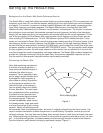
6
ENGLISH
Setting up the RESOLV 80a
Background on the Resolv 80a Studio Reference Monitor
The Resolv 80a is a near field reference monitor featuring a custom designed, 20.3 cm copolymer, low
frequency driver and a 2.5 cm titanium tweeter, employing a Ferro fluid cooled voice coil and neodymi-
um magnet. The monitor’s crossover has been carefully designed with high quality components insur-
ing a linear frequency and phase response. The Resolv 80a enclosure is constructed from MDF
(Medium Density Fiberboard) and is finished in scuff resistant, textured paint. The monitor’s enclosure
also includes a tuned vent port that provides extended low-end response, and with a low turbulence
design, the low frequency driver can move freely with minimal effect on the overall impedance. On the
rear of the enclosure you’ll find Resolv 80a’s control panel, which features a variety of input connec-
tions including XLR balanced input, 1/4-inch TRS balance input and RCA unbalanced input. These
inputs are connected to Resolv 80a’s internal bi-amp power module providing 75 watts of power for the
low frequency woofer, an active crossover, and 25 watts of power for the high frequency tweeter. You
will also find the pre-amp controls, including VOLUME knob, used to adjust the overall level of the inter-
nal power amplifier, as well as the innovative MID PRESENCE control. This four-position switch allows
the mix engineer to contour the mid-range response of the monitor from a traditional hi-fi sound to flat
and then through two levels of aggressive mid-range response. The Resolv 80a has been designed to
provide flat, accurate monitoring, and at the same time, to provide an adjustable response curve so
that the sound of other popular nearfield monitors can be easily emulated.
Positioning the Resolv 80a
Near field monitoring has become
the choice of many engineers in
large and small studios because it
minimizes the effect of room
acoustics. This is especially impor-
tant in today’s project studios since
the budget for room acoustics is
often close to nothing. By position-
ing the reference monitors in the
near field (close to the listeners),
you can greatly reduce the effects
of room acoustics. The most impor-
tant considerations when evaluating
the effects of room acoustics are
reflective surfaces that are around
the monitoring area. These can
include flat tabletops, glass mirrors
or framed pictures, large open walls
and even the surface of your mixing
console. Mostly all reflecting sound
will eventually reach the listening position, but since it is slightly delayed from the direct source, the
result is random cancellation of some frequencies, or comb filtering. If possible, remove any and all
reflective surfaces. You may also want to hang some acoustic foam on walls that are close to the moni-
tors. When positioning the monitors you’ll want to set up what is commonly referred to as the “mix trian-
gle”. In this ideal configuration, the space between the left and right monitor is equal to the distance
from the listener to each monitor, forming an equilateral triangle. (Figure 1.)
Prime Listening Spot
Equal Distance
Figure 1.


















